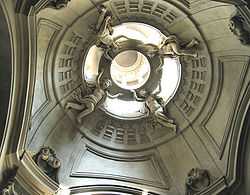Antonio Gherardi

Antonio Gherardi (September 20, 1638 – May 10, 1702) was an Italian painter, architect, and sculptor (stuccoist) of the Baroque style, active mainly in and near Rome and his native city of Rieti.
His original name was Antonio Tatoti, but when he moved to Rome (c. 1656) from Rieti, he changed his surname. His father died when he was only eight years old, and in 1656, Monsignor Bulgarino Bulgarini, Governor of Rieti, became his patron. Two years later Bulgarini sponsored his travel to Rome, and introduced him to his future mentors, Pier Francesco Mola and Pietro da Cortona. In the large workshops organized by the latter, he developed skills in both painting and stucco decoration. In 1674, he joined the Accademia di San Luca.
Although he did not build much, Gherardi's mature architecture is extraordinarily inventive. Designed in a late Baroque manner, he drew freely on forms and ideas of Bernini, Borromini and Cortona to make his inventions. The best examples of his work can be seen in the Santa Cecilia Chapel, San Carlo ai Catinari and the Avila Chapel, Santa Maria in Trastevere, both in Rome.
In 1698 he was appointed architect and painter of the chapel of Santa Teresa in Santa Maria in Traspontina, which still preserves a painting of the Ecstasy of Santa Teresa .
Among his works are
- The decoration of the vault of Santa Maria in Trivio, Scenes from the Life of the Virgin, (1668–1670)
- Birth of the Virgin in the Duomo of Gubbio
- Death of Blessed Francesco (1675) and architecture, Chapel of the Blessed Francesco Solano in Santa Maria in Aracoeli, Rome).
- Education of the Virgin (c. 1675, 2nd chapel on left of Duomo of Poggio Mirteto).
- Holy family with young John the Baptist, (c. 1675, Duomo of Monterotondo).
- Scenes from the Life of Esther, (1673–1674, Palazzo Naro, Rome)
- Crucifixion, (1674–1686, Santi Claudio e Andrea dei Borgognoni, Rome, lost).
- Vision of S. Filippo Neri & S. Camillo de Lellis heals dying Crescenzi family member, (1677, sacristy, Santa Maria in Trivio).
- Stucco for main altar (1677, Santa Maria in Trivio).
- The miracle of Holy Shroud & Christ lying on Shroud with Donors from House of Savoy and Sts. Massimo & Maurizio, Blessed Amedeo, Margherita & Ludovica, (1680–1682, Altarpiece, Santissimo Sudario dei Piemontesi; payment 140 scudi).
- Saint Jerome penitent in desert, (1680, painted to substitute for painting by Durante Alberti) and the architecture of the Avila chapel in Santa Maria in Trastevere
- Santa Cecilia (1692) and the architecture of the Santa Cecilia Chapel (1695–1700) in San Carlo ai Catinari
- Ecstasy of Saint Theresa (1698, Santa Maria in Traspontina, Rome).
- Immaculate Conception for church of Sant'Antonio al Monte, Rieti.
- Ephemeral funerary decorations for Alfonso di Portugal in Sant'Antonio dei Portoghesi, also others to celebrate the extirpation of Calvinism in France.
External links
| Wikimedia Commons has media related to Antonio Gherardi. |
|